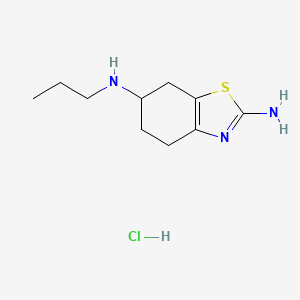
6-N-propyl-4,5,6,7-tetrahydro-1,3-benzothiazole-2,6-diamine;hydrochloride
- 専門家チームからの見積もりを受け取るには、QUICK INQUIRYをクリックしてください。
- 品質商品を競争力のある価格で提供し、研究に集中できます。
概要
説明
®-Pramipexole (dihydrochloride), also known as R-(+)-Pramipexole (dihydrochloride) and KNS-760704 (dihydrochloride), is a small molecule drug developed by the University of Virginia. It is a free radical scavenger, dopamine receptor agonist, and apoptosis inhibitor. This compound has been investigated for its potential therapeutic effects in various conditions, including hypereosinophilic syndromes, amyotrophic lateral sclerosis, and chronic obstructive pulmonary disease .
準備方法
Synthetic Routes and Reaction Conditions
The synthesis of ®-Pramipexole (dihydrochloride) involves several steps, starting from commercially available starting materialsThe reaction conditions typically involve the use of organic solvents, catalysts, and specific temperature and pressure conditions to ensure high yield and purity .
Industrial Production Methods
Industrial production of ®-Pramipexole (dihydrochloride) follows similar synthetic routes but on a larger scale. The process is optimized for cost-effectiveness, scalability, and compliance with regulatory standards. This involves the use of large-scale reactors, continuous flow processes, and stringent quality control measures to ensure the consistency and safety of the final product .
化学反応の分析
Types of Reactions
®-Pramipexole (dihydrochloride) undergoes various chemical reactions, including:
Oxidation: Involves the addition of oxygen or the removal of hydrogen.
Reduction: Involves the addition of hydrogen or the removal of oxygen.
Substitution: Involves the replacement of one functional group with another.
Common Reagents and Conditions
Common reagents used in these reactions include oxidizing agents (e.g., hydrogen peroxide), reducing agents (e.g., sodium borohydride), and various catalysts (e.g., palladium on carbon). The reaction conditions vary depending on the specific reaction but generally involve controlled temperature, pressure, and pH .
Major Products
The major products formed from these reactions depend on the specific reaction pathway. For example, oxidation may yield hydroxylated derivatives, while reduction may produce dehydroxylated compounds .
科学的研究の応用
Chemistry: Used as a model compound for studying free radical scavenging and dopamine receptor agonism.
Biology: Investigated for its effects on cellular apoptosis and oxidative stress.
Medicine: Explored as a therapeutic agent for conditions such as hypereosinophilic syndromes, amyotrophic lateral sclerosis, and chronic obstructive pulmonary disease.
作用機序
®-Pramipexole (dihydrochloride) exerts its effects through multiple mechanisms:
Dopamine Receptor Agonism: Activates dopamine receptors, leading to increased dopamine signaling.
Free Radical Scavenging: Neutralizes free radicals, reducing oxidative stress and cellular damage.
Apoptosis Inhibition: Inhibits programmed cell death, promoting cell survival
類似化合物との比較
Similar Compounds
Pramipexole (dihydrochloride): A non-selective dopamine receptor agonist used in the treatment of Parkinson’s disease.
Ropinirole (hydrochloride): Another dopamine receptor agonist used for similar indications.
Rotigotine (transdermal system): A dopamine agonist administered via a transdermal patch for Parkinson’s disease and restless legs syndrome.
Uniqueness
®-Pramipexole (dihydrochloride) is unique due to its combined properties of dopamine receptor agonism, free radical scavenging, and apoptosis inhibition. This multifaceted mechanism of action makes it a promising candidate for various therapeutic applications, particularly in neuroprotection and anti-inflammatory treatments .
特性
分子式 |
C10H18ClN3S |
|---|---|
分子量 |
247.79 g/mol |
IUPAC名 |
6-N-propyl-4,5,6,7-tetrahydro-1,3-benzothiazole-2,6-diamine;hydrochloride |
InChI |
InChI=1S/C10H17N3S.ClH/c1-2-5-12-7-3-4-8-9(6-7)14-10(11)13-8;/h7,12H,2-6H2,1H3,(H2,11,13);1H |
InChIキー |
YLOYRMPMRZXEMW-UHFFFAOYSA-N |
正規SMILES |
CCCNC1CCC2=C(C1)SC(=N2)N.Cl |
製品の起源 |
United States |
Synthesis routes and methods
Procedure details





試験管内研究製品の免責事項と情報
BenchChemで提示されるすべての記事および製品情報は、情報提供を目的としています。BenchChemで購入可能な製品は、生体外研究のために特別に設計されています。生体外研究は、ラテン語の "in glass" に由来し、生物体の外で行われる実験を指します。これらの製品は医薬品または薬として分類されておらず、FDAから任何の医療状態、病気、または疾患の予防、治療、または治癒のために承認されていません。これらの製品を人間または動物に体内に導入する形態は、法律により厳格に禁止されています。これらのガイドラインに従うことは、研究と実験において法的および倫理的な基準の遵守を確実にするために重要です。














